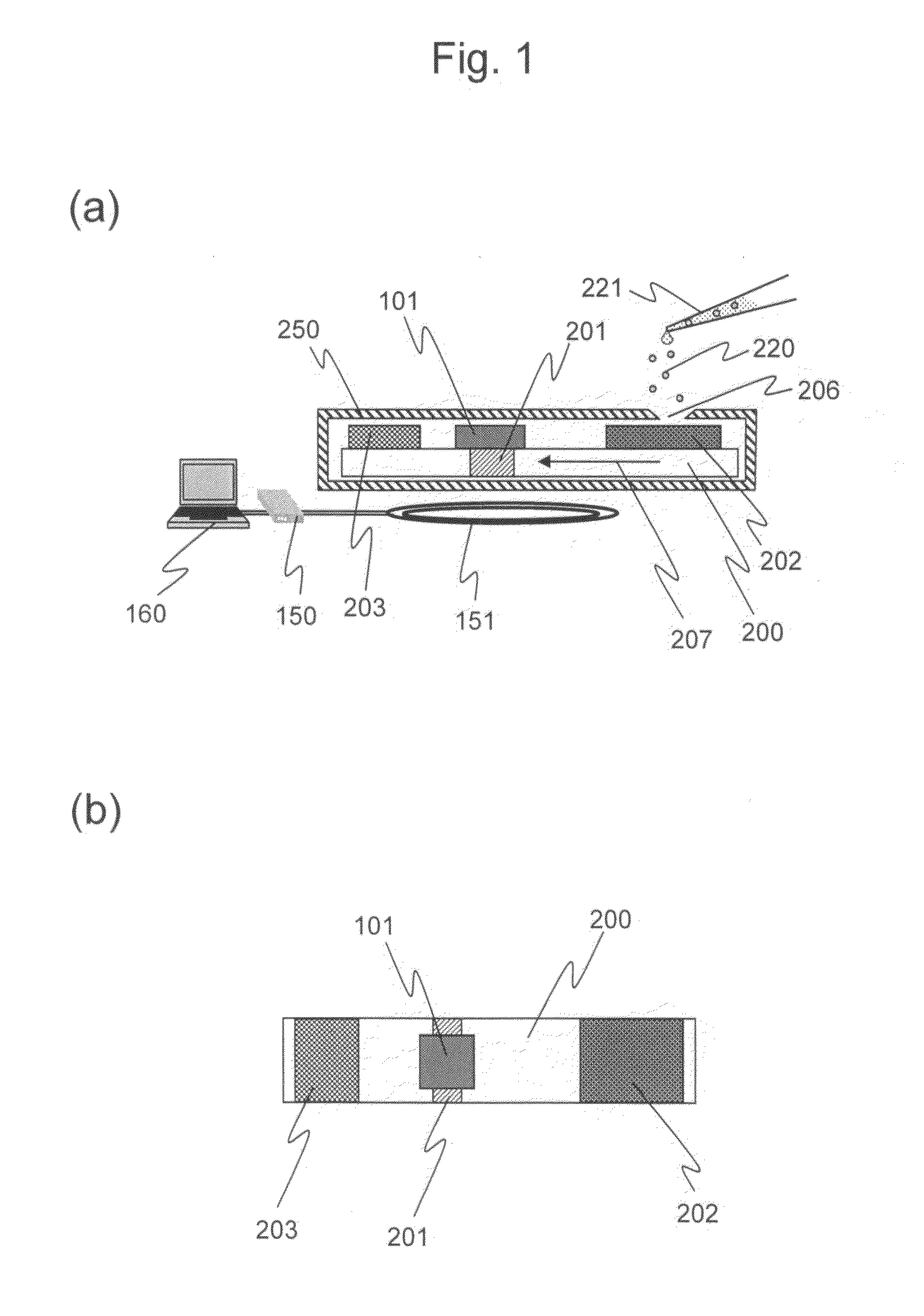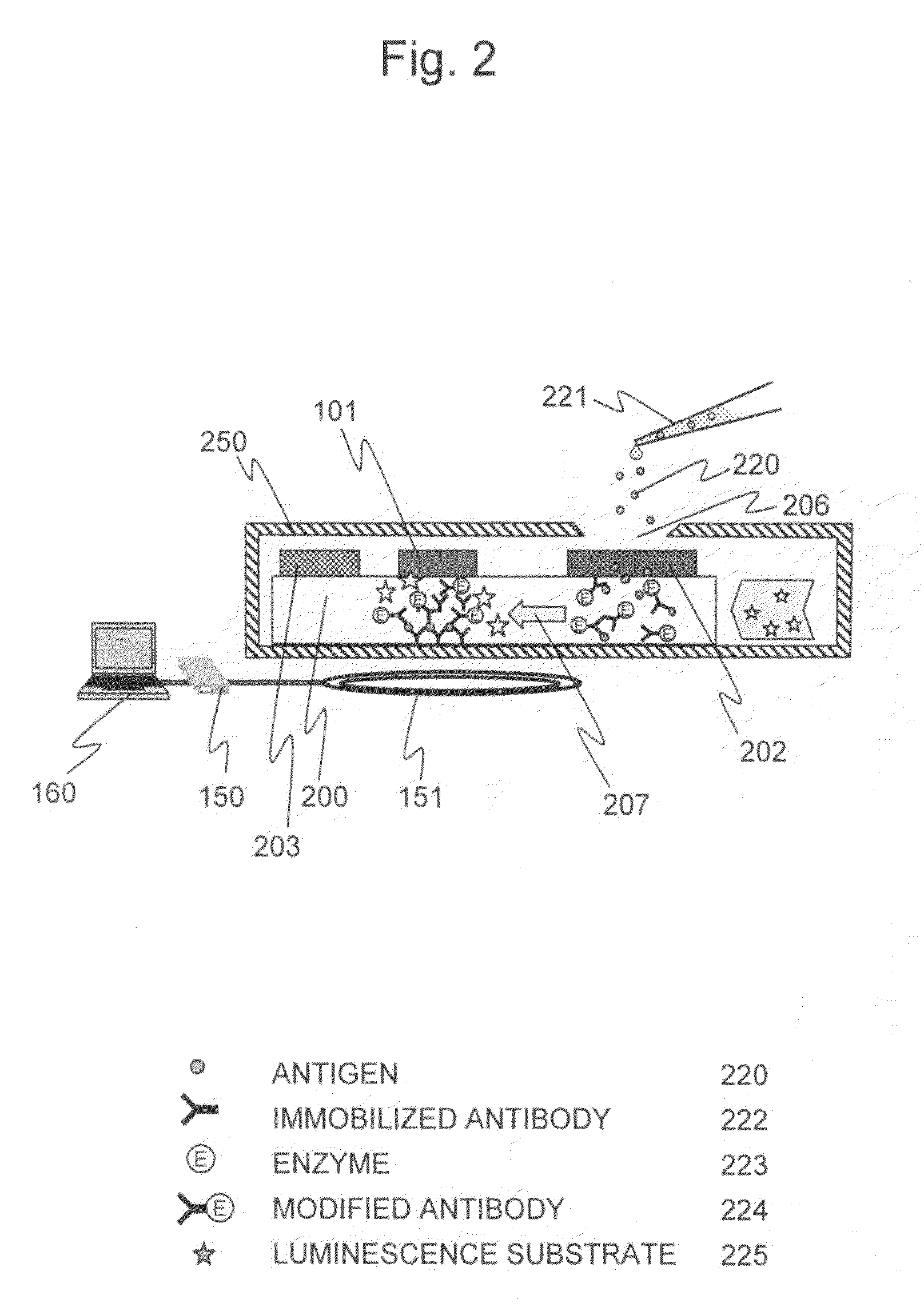Analysis kit for living organism and chemical reaction
a technology for living organisms and kits, applied in the field of reaction analysis kits, can solve the problems of less sensitive, difficult quantification, rapid proliferation, etc., and achieve the effects of reducing background signal, simplifying detection mechanism, and low cost reaction analysis
- Summary
- Abstract
- Description
- Claims
- Application Information
AI Technical Summary
Benefits of technology
Problems solved by technology
Method used
Image
Examples
example 1
[0053]A first example of the present invention will be described with reference to FIGS. 1 to 4. A shielding container 250 houses a dry membrane 200 where an antibody is immobilized. Examples of the material of the membrane include nitrocellulose, nylon, and PVDF (polyvinylidene-Fluoride). Among them, nitrocellulose is frequently used because an antibody can be easily immobilized. The sandwich method is used to detect and quantify a substance to be analyzed, as in immunochromatography. An antibody that specifically binds to a target antigen is immobilized to a portion (test section) 201 of the membrane 200, as shown in FIG. 2. A sample extracted from blood or the like is dripped to a sample introduction section 206 above the membrane 200 through an opening provided in the shielding container 250.
[0054]An enzyme-conjugated antibody 224 specific to the antigen of the substance to be analyzed is held in advance in a sample pad 202 placed in the sample introduction section 206 above the...
example 2
[0062]As a second example, a description will be made of the case where a projection is provided in the shielding container and an incoming light absorber is provided in the membrane in order to prevent external light from entering with reference to FIG. 6.
[0063]To accurately measure chemical luminescence using the sensor element, it is necessary to provide means for preventing external light from entering. In the reaction analysis kit according to the present invention, since the opening is provided in the shielding container 250 at the sample introduction section 206 in order to introduce a sample into the membrane 200, it is desirable to block external light from entering through this opening. First, a projection is therefore provided in the shielding container 205 in such a way that the projection fills the gap between the shielding container and the membrane. The projection to be provided includes at least one of a projection 252 extending from the inner upper surface of the sh...
example 3
[0065]As a third example, a description will be made of the case where a light-blocking filter is used with reference to FIG. 7.
[0066]This example aims to prevent light from entering through the opening in the shielding container 250 above the upper part of the sample introduction section 206, as in Example 2. A light-blocking, solution-permeable filter 205 is disposed inside the shielding container 250 such that it covers the opening in the container. Examples of the material of the light-blocking filter include glass fibers, nitrocellulose, PVDF and nylon. For example, the light-blocking property can be imparted by mixing the dye that stains the membrane shown in Example 2 with the light-blocking filter or adsorbing the dye on the surface of the light-blocking filter depending on the material of the light-blocking filter.
PUM
| Property | Measurement | Unit |
|---|---|---|
| diameter | aaaaa | aaaaa |
| diameter | aaaaa | aaaaa |
| diameter | aaaaa | aaaaa |
Abstract
Description
Claims
Application Information
 Login to View More
Login to View More - R&D
- Intellectual Property
- Life Sciences
- Materials
- Tech Scout
- Unparalleled Data Quality
- Higher Quality Content
- 60% Fewer Hallucinations
Browse by: Latest US Patents, China's latest patents, Technical Efficacy Thesaurus, Application Domain, Technology Topic, Popular Technical Reports.
© 2025 PatSnap. All rights reserved.Legal|Privacy policy|Modern Slavery Act Transparency Statement|Sitemap|About US| Contact US: help@patsnap.com



